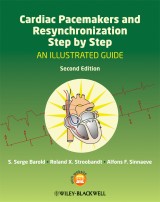Details

Cardiac Pacemakers and Resynchronization Step by Step
An Illustrated Guide2. Aufl.
|
64,99 € |
|
| Verlag: | Wiley-Blackwell |
| Format: | |
| Veröffentl.: | 08.06.2010 |
| ISBN/EAN: | 9781444323221 |
| Sprache: | englisch |
| Anzahl Seiten: | 480 |
DRM-geschütztes eBook, Sie benötigen z.B. Adobe Digital Editions und eine Adobe ID zum Lesen.
Beschreibungen
This new edition of the bestselling step-by-step introduction to cardiac pacemakers now includes additional material on CRT and an accompanying website. It retains the effective use of full-page illustrations and short explanations that gained the book such enormous popularity and now provides information on recent advances in cardiac pacing, including biventricular pacing for the treatment of heart failure.
Preface to the first edition. <p>Preface to the second edition.</p> <p>Abbreviations.</p> <p><b>Color Plate Section.</b></p> <p>What is a pacemaker?</p> <p>Recording pacemaker activity.</p> <p>Fundamentals of electricity.</p> <p>Ventricular stimulation.</p> <p>Pacing leads.</p> <p>Sensing – basic concepts.</p> <p>Sensing – advanced concepts.</p> <p>Basic pacemaker electrocardiography.</p> <p>Other single chamber pacemakers.</p> <p>DDD pacemakers – basic functions.</p> <p>DDD pacemakers – upper rate response.</p> <p>Atrioventricular interval.</p> <p>Retrograde ventriculoatrial synchrony in dual chamber pacemakers.</p> <p>All dual chamber pacemakers function in the DDD mode.</p> <p>Types of lower rate timing.</p> <p>Atrial capture.</p> <p>Automatic mode switching.</p> <p>Pacemaker radiography.</p> <p>Oversensing.</p> <p>Troubleshooting.</p> <p>Pacemaker hemodynamics and rate-adaptive pacing.</p> <p>Pacemaker tachycardias – Part 1.</p> <p>Pacemaker tachycardias – Part 2.</p> <p>Treatment of tachycardia.</p> <p>Pacemaker interference.</p> <p>Pacemaker follow-up.</p> <p>Remote pacemaker monitoring.</p> <p>Special functions.</p> <p>Biventricular pacing and cardiac resynchronization.</p> <p>Conclusion.</p> <p><b>Text: Overview of cardiac pacing and cardiac resynchronization Cardiac pacing.</b></p> <p>Implantation.</p> <p>Basic function.</p> <p>Power source.</p> <p>Rate or interval?</p> <p>Single chamber pacemakers.</p> <p>Basic electricity.</p> <p>Chronic pacing threshold and safety margin.</p> <p>Sensing.</p> <p>Polarity: unipolar versus bipolar pacing and sensing.</p> <p>Ventricular fusion and pseudofusion beats.</p> <p>Operational characteristics of a simple DDD pacemaker.</p> <p>Crosstalk and crosstalk intervals.</p> <p>Increasing complexity: our simple DDD pacemaker grows to nine intervals.</p> <p>Upper rate response of DDD pacemakers.</p> <p>Lower rate timing of dual chamber pacemakers.</p> <p>Phantom programming.</p> <p>Programmability of lower rate.</p> <p>Endless loop tachycardia.</p> <p>Repetitive non-reentrant VA synchrony: the cousin of endless loop tachycardia.</p> <p>Types of dual chamber pacemakers.</p> <p>Overdrive suppression and the underlying rhythm.</p> <p>Pacemaker hemodynamics.</p> <p>Rate-adaptive pacemakers.</p> <p>The pacemaker stimulus.</p> <p>Magnet mode.</p> <p>Normal QRS patterns during right ventricular pacing.</p> <p>Left ventricular endocardial pacing.</p> <p>Manifestations of myocardial infarction in the paced rhythm.</p> <p>Cardiac memory.</p> <p>Pacemaker alternans.</p> <p>Complications of pacemakers.</p> <p>Non-electrical complications.</p> <p>Electrical complications.</p> <p>Automatic mode switching.</p> <p>Minimizing right ventricular pacing.</p> <p>Effect of drugs and electrolyte imbalance.</p> <p>Magnet application.</p> <p>Capture verification algorithms.</p> <p>Keeping good records.</p> <p>Factors influencing pacemaker longevity.</p> <p>Pacemaker follow-up.</p> <p>The pacemaker as an implantable Holter system.</p> <p>Special functions of pacemakers.</p> <p><b>Cardiac resynchronization (CRT).</b></p> <p>CRT hemodynamics.</p> <p>CRT with only left ventricular pacing.</p> <p>New York Heart Association class I and II patients with left bundle branch block and depressed left ventricular function.</p> <p>Right bundle branch block.</p> <p>CRT in patients with a narrow QRS complex.</p> <p>Impact of CRT.</p> <p>Alternative routes to left ventricular pacing.</p> <p>What is a CRT responder?</p> <p>Complications of CRT implantation.</p> <p>Impact of comorbidities.</p> <p>Programming of CRT devices.</p> <p>Atrial fibrillation and atrial tachyarrhythmia.</p> <p>Congestive heart failure after CRT.</p> <p>Arrhythmias after CRT.</p> <p><b>Appendix: Guidelines.</b></p> <p>American guidelines for pacemaker implantation.</p> <p>European guidelines for pacemaker implantation.</p> <p>Commentary.</p> <p>Further reading.</p> <p>Index.</p>
<p>"I have found this book to be invaluable for my own learning and strongly recommend it to those beginning to work in cardiac pacing and also to those with more advanced knowledge. The excellent illustrations make the book extremely easy to understand, and it represents excellent value for money with the additional website resource. Thoroughly recommended.” (<i>Cardiology News</i>, 1 April 2013)</p> <p>"This is a simple book that makes reading about cardiac pacemakers and resynchronization therapy interesting and interactive. It is an effective tool for understanding more about pacing and cardiac resynchronization therapy." (Doody's, 23 September 2011)</p> <p> </p>
<b>S. Serge Barold</b>, University of South Florida College of Medicine, Tampa, FL, USA <p><b>Roland X. Stroobandt</b></p> <p><b>Alfons F. Sinnaeve</b></p>


















